| Census | Topology | Info Maps | Info Landscapes | Info Spaces | ISP Maps | Weather Maps |
| Wireless | Web Site Maps | Surf Maps | MUDs & Virtual Worlds | Historical |
|
Sorry, the Cybergeography Research web pages are no longer being updated. The project ran from 1997-2004, but my research has moved away into other areas (see my blog for latest). If you have any questions or comments, please email me at: m.dodge (at) manchester.ac.uk. Cheers, Martin Dodge, February 2007. |

| The conceptions and representations of Cyberspace created by artists in literature, art, computer games, films and television have a powerful influence on how we perceive these new spaces. |
| William Gibson's evocative and oft-quoted description of Cyberspace from his 1984 novel Neuromancer. The one that started it all in many respects: | 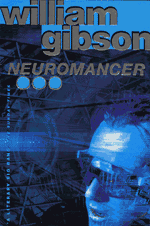 |
| "Cyberspace. A consensual hallucination experienced daily by billions of legitimate operators, in every nation, by children being taught mathematical concepts...A graphical representation of data abstracted from the banks of every computer in the human system. Unthinkable complexity. Lines of light ranged in the non-space of the mind, clusters and constellations of data. Like city lights, receding..." (William Gibson, Neuromancer, 1984, page 51) |
| Another quote from William Gibson's famous novel: |
| "Home was BAMA, the Sprawl, the Boston-Atlanta Metropolitan Axis. Program a map to display frequency data exchange, every thousand megabytes a single pixel on a very large screen. Manhattan and Atlanta burn solid white. Then they start to pulse, the rate of traffic threatening to overload your simulation. Your map is about to go nova. Cool it down. Up your scale. Each pixel a million megabytes. At a hundred million megabytes per second, you begin to make out certain blocks in midtown Manhattan, outlines of hundred-year-old parks ringing the old core of Atlanta." (William Gibson, "Neuromancer", 1984, page 57). |
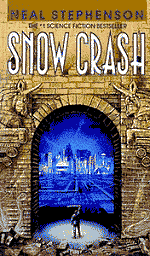 |
Neal Stephenson's vividly imagined virtual reality world of the Metaverse from his 1992 novel Snow Crash: |
| "It is the Broadway, the Champs Élyseés of the Metaverse. It is the brilliantly lit boulevard .... The dimensions of the Street are fixed by a protocol, hammered out by the computer graphics ninja overlords of the Association for Computing Machinery's Global Multimedia Group... Like any place in Reality, the Street is subject to development. Developers can build their own small streets feeding off of the main one. They can build buildings, parks, signs, as well as things that do not exist in Reality, such as vast hovering overhead light shows and special neighborhoods where the rules of three-dimensional spacetime are ignored. Put a sign or a building on the Street and the hundred million richest, hippest, best-connected people on the earth will see it every day of their lives." (Neal Stephenson, Snow Crash, 1992, pages 24-25) |
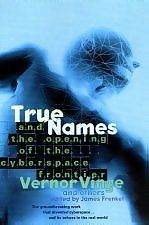 |
|
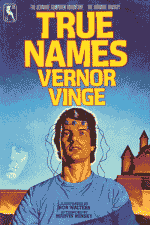 |
|
"He powered up his processors, settled back in his favorite chair, and carefully attached the Portal's five sucker electrodes to his scalp. For long minutes nothing happened: a certain amount of self-denial -- or at least self-hypnosis -- was necessary to make the ascent. Some experts recommended drugs or sensory isola- tion to heighten the user's sensitivity to the faint, ambiguous signals that could be read from the Portal. Pollack, who was certainly more experienced than any of the pop experts, had found that he could make it simply by staring out into the trees and listening to the wind-surf that swept through their upper branches. And just as a daydreamer forgets his actual surroundings and sees other realities, so Pollack drifted, detached, his subconscious interpreting the status of the West Coast communication and data services as a vague thicket for his conscious mind to inspect, interrogate for the safest path to an intermediate haven. Like most exurb data-commuters, Pollack rented the standard optical links: Bell, Boeing, Nippon Electric. Those, together with the local West Coast data companies, gave him more than enough paths to proceed with little chance of detection to any accepting processor on Earth. In minutes, he had traced through three changes of carrier and found a place to do his intermediate computing. The comsats rented processor time almost as cheaply as ground stations, and an automatic payment transaction (through several dummy accounts set up over the last several years) gave him sole control of a large data space within milliseconds of his request. The whole process was almost at a subconscious level -- the proper functioning of numerous routines he and others had devised over the last four years. Mr. Slippery (the other name was avoided now, even in his thoughts) had achieved the fringes of the Other Plane. (Vernor Vinge, True Names, 1981.) |
|
Warriors of the Net is a short movie that wonderfully shows how the Internet works from the viewpoint of individual data packets. It was created by Gunilla Elam, Tomas Stephansson, Niklas Hanberger and Monte Reid, at the Ericsson Medialab, in Sweden. This image shows different data packets speeding through a LAN. |
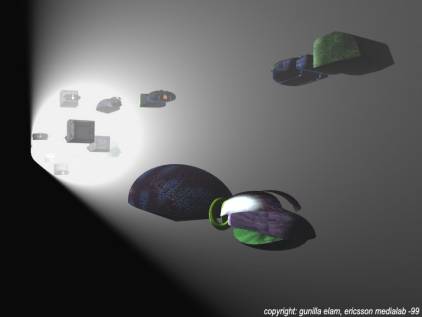 |
|
While the image opposite is the view of the global Internet from the movie, visualised as a complex mesh of glowing links floating in empty space. The full twelve minute movie is available, but be warned it is 96 meg. But I think it is well worth the download. [ Read the Map of the Month article "Imagining the Inner Workings of the Internet", Mappa.Mundi Magazine, September 2001. ] |
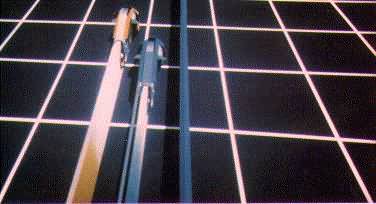
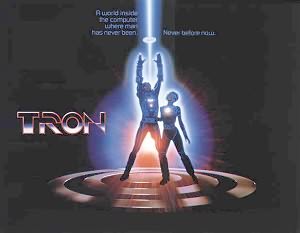
|
The film Tron, made in 1982, pioneered the use of computer generated special effects and also provided influential representations of virtual space within a computer. Particularly memorable was the light bike chases shown in the image above and below. The film was made by Walt Disney Pictures and was directed by Steven Lisberger and starred Jeff Bridges and Bruce Boxleitner. See the Tron Page by Guy Gordon for more information. |
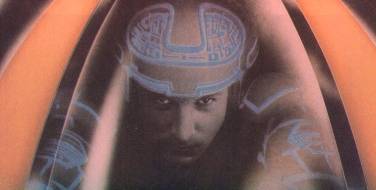
| Johnny Mnemonic was scripted by William Gibson himself, from one of his short stories. It was released by Tristar Pictures in 1995, directed by Robert Longo and starring Keanu Reeves, Dina Meyer and Ice-T. |
(Image courtesy of C.O.R.E. Digital Picture.) |
|
There were three major sequences in the film visualising Cyberspace and these were created by different special effects companies. The "Internet navigation" sequence was created by Sony Pictures Imageworks, the "Digital Dream" sequence was by Braid Media Arts. Lastly, the "Data Upload" sequence was created by C.O.R.E. Digital Pictures. The striking image above is taken from their work, visualising loading vast volumes of data into Cyberspace. Film reviews of Johnny Mnemonic are listed at the The Linköping Science Fiction & Fantasy Archive. An article by Artie Romero called "Hollywood Goes Cyberpunk" give more details on Braid Media Arts work on visualising Cyberspace in the film. While Steve Napleton's academic paper, "Johnny Mnemonic: Cyberspace and the Displacement of Digital Anxiety in Hollywood Cinema" provides a detailed analysis of the film. |
|
| The 1995 film Hackers,
directed by Iain Softley and starring Jonny Lee Miller and Angelina
Jolie. The key Cyberspace representation in the film was the "City of
Text" dataspace. This was visualised as a Gibsonian urban landscape of
skyscrapers of pulsing information and computer circuitry, as shown by
the image below. It was created by Artem
Visual Effects, based in London.
There is also an official Hackers site. |
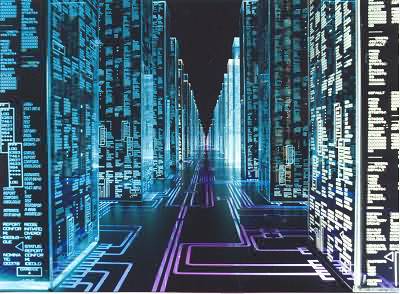
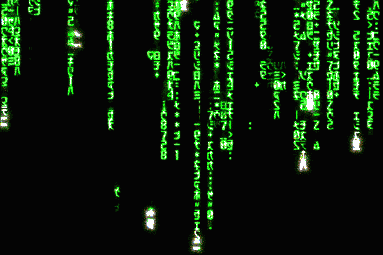 |
The Matrix by Andy and Larry Wachowski's, starring Keanu Reeves, Laurence Fishburne, and Carrie-Anne Moss, was a major hit in 1999. The official film web site is What Is The Matrix. The key representation of cyberspace in the film was the eerie green flowing computer code, culminating in the final battle with the AI agents in the 'corridor of code'. These striking images were created by Animal Logic, a special effects company in Australia. |
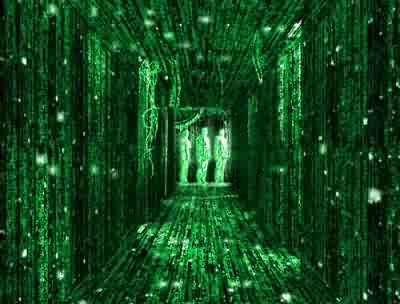
![]()
|
These two images are from the work of Marcos Novak. Novak is a transarchitect: an architect, artist, composer, and theorist who employs algorithmic techniques to design actual, virtual and hybrid intelligent environments. He is visiting Associate Professor at the Department of Architecture and Urban Design at UCLA and his homepage contains many more striking examples of his work. |
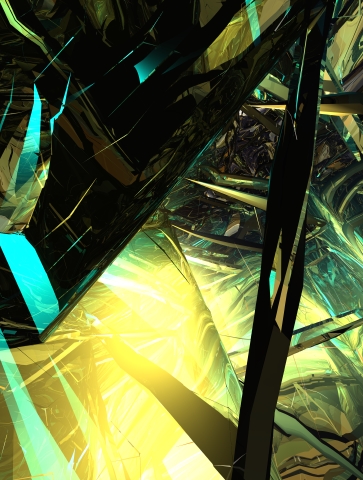 |
![]()
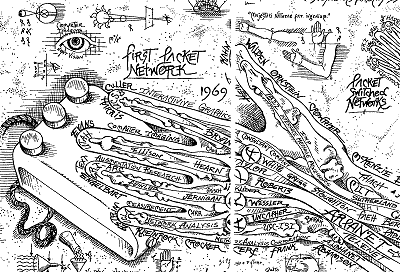 |
This ancient scroll is an
artistic rendering of the early history of networking and ARAPNET,
celebrating the key people who created it.
|
|
The scroll was produced by Roland Bryan, himself an ARPANET pioneer at University of California Santa Barbara. The scroll itself is available from the Internet Archive's collection of ARPANET documents (no. 140). (Further historical maps are available on the Atlas of Cyberspaces.) |
|
![]()
|
|
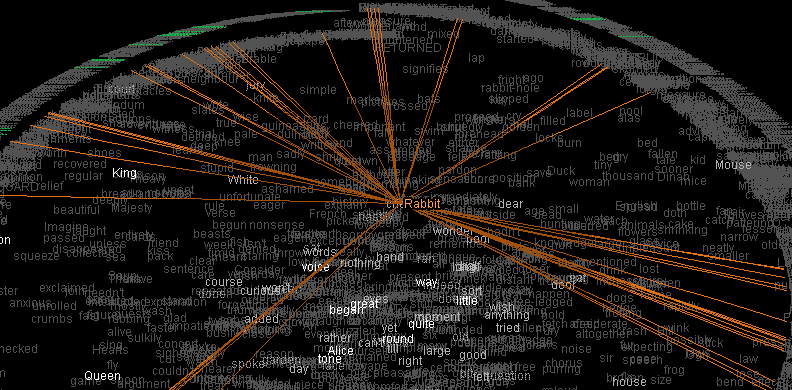 |
|
These images show different views of WonderWalker: a global online wunderkammer, created by Marek Walczak and Martin Wattenberg and commissioned by Gallery 9, Walker Arts Center. It is a collaborative collection of web objects and provides different interactive map views of these objects. Other examples of Martin Wattenberg's work are shown on the Information spaces page. |
|
![]()
|
Shredder is a net-art feature that literally shreds the nicely designed web page, rendering pages in a strange new chaotic forms. It was created by Mark Napier, POTATOLAND.org. The image below is the result of apply Shredder to the web site maps page of the Atlas of Cyberspaces. |
| A screen-shot of I/O/D 4 Web Stalker, an interesting, but somewhat experimental, web browser which includes mapping functions. |
![]()
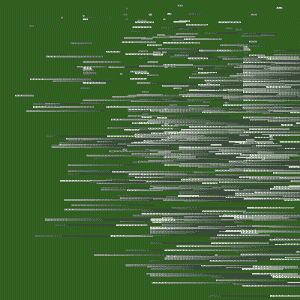 |
These images are results from Lisa Jevbratt's net art project Mapping the Web Infome. Software was written for the project to crawl and visualize web sites. It can produce 3 distinct types of 'maps' - coloured link graphs, pixel dot maps, and textual html listings. This software was then employed by different artists to create their own maps of parts of the Web. The top image was created by Kazunori Takahashi and the bottom one by Lev Manovich.
Other notable mapping art works by Jevbratt include the 1:1 project. |
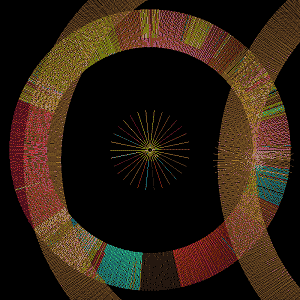 |
![]()
|
Sorry, the Cybergeography Research web pages are no longer being updated. The project ran from 1997-2004, but my research has moved away into other areas (see my blog for latest). If you have any questions or comments, please email me at: m.dodge (at) manchester.ac.uk. Cheers, Martin Dodge, February 2007. |